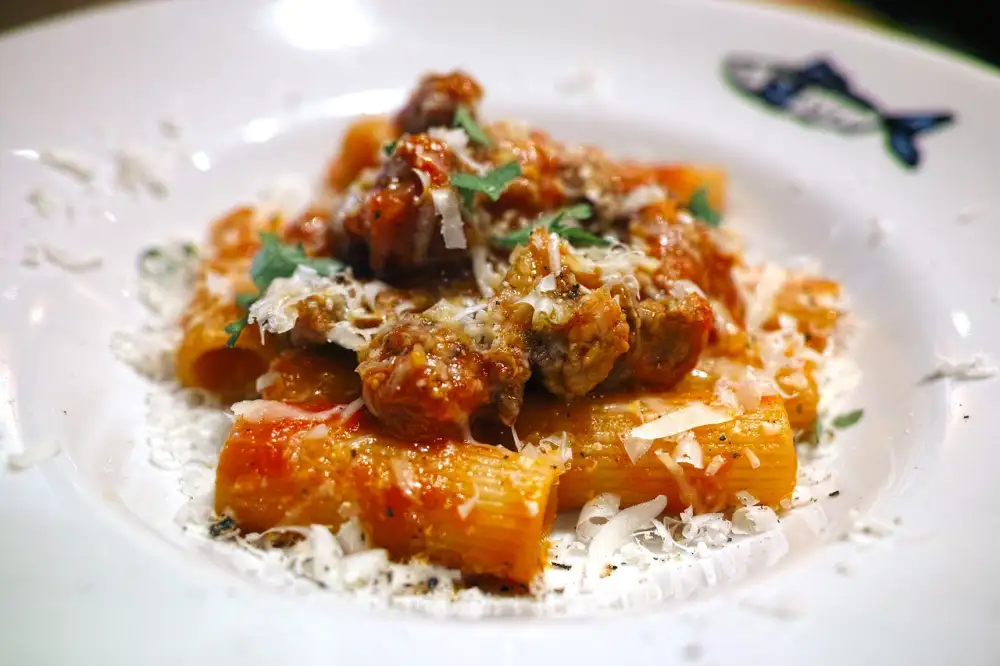Deliciously Authentic Ragu Recipes: Unleash the Flavors of Italian Cuisine

- History and Origins of Ragu
- Essential Ingredients for Authentic Ragu
- Step-by-Step Guide to Making Ragu from Scratch
- Variations and Adaptations of Ragu Recipes
- Serving Suggestions and Pairings for Ragu
- Tips and Tricks for Perfecting Your Ragu
- Health Benefits of Ragu: Nutritional Value and Balance
- Frequently Asked Questions about Ragu
Ragu is a classic Italian meat-based sauce that has been enjoyed for centuries. Its rich and hearty flavors make it a staple in Italian cuisine, adding depth and complexity to any dish it accompanies. Whether served over pasta, polenta, or as a filling for lasagna, ragu is a versatile sauce that can elevate any meal. Join us as we delve into the history, ingredients, and techniques behind this deliciously authentic Italian sauce.
History and Origins of Ragu
Ragu, a classic Italian meat-based sauce, has a rich history and fascinating origins. The word "ragu" is derived from the French term "ragout," which means to revive or restore. It was introduced to Italy in the late 18th century by Napoleon's troops, who brought with them the tradition of slow-cooked meat stews.
However, the true origins of ragu can be traced back even further to medieval times when it was a popular dish among Italian peasants. They would slow-cook tough cuts of meat with vegetables and herbs for hours, creating a flavorful and hearty sauce.
Over time, ragu evolved into a staple in Italian cuisine, particularly in the regions of Emilia-Romagna and Bologna. In Bologna, ragu is known as "ragù alla bolognese" and is traditionally made with ground beef or veal, onions, carrots, celery, tomatoes, wine, and milk.
Ragu gained international recognition when it became one of the key components of pasta dishes such as spaghetti bolognese. Its popularity spread beyond Italy's borders, becoming a beloved sauce worldwide.
Today, ragu continues to be cherished for its depth of flavor and versatility. Its history and origins serve as a reminder of how food traditions can transcend time and borders while bringing people together through shared culinary experiences.
Essential Ingredients for Authentic Ragu
To create an authentic and flavorful ragu, it is crucial to use the right ingredients. Here are the essentials:
1. Meat: Traditional ragu is made with a combination of beef, pork, and veal. The mix of meats adds depth and richness to the sauce.
2. Aromatics: Onions, carrots, and celery form the base of the sauce. They provide a sweet and savory flavor profile.
3. Tomatoes: San Marzano tomatoes are preferred for their rich taste and low acidity. You can use whole canned tomatoes or tomato paste for a concentrated flavor.
4. Herbs and Spices: Fresh basil, oregano, thyme, and bay leaves add aromatic notes to the sauce. Garlic, salt, and pepper enhance the overall taste.
5. Wine: Red wine like Chianti or Barolo is commonly used in ragu recipes. It adds complexity and depth to the sauce.
6. Stock or Broth: Beef or vegetable stock helps to simmer the meat until tender while infusing flavors into the sauce.
Remember that using high-quality ingredients will elevate your ragu's taste and authenticity.
Step-by-Step Guide to Making Ragu from Scratch
1. Start by selecting high-quality ingredients such as lean ground beef, onions, carrots, celery, garlic, tomatoes, and herbs like thyme and bay leaves.
2. Heat olive oil in a large pot over medium heat. Add the onions, carrots, and celery and cook until they become soft and translucent.
3. Add the minced garlic and cook for another minute until fragrant.
4. Increase the heat to medium-high and add the ground beef to the pot. Break it up with a wooden spoon and cook until browned.
5. Pour in crushed tomatoes and tomato paste, stirring well to combine all the ingredients.
6. Season with salt, pepper, dried herbs like thyme and oregano, and add bay leaves for extra flavor.
7. Reduce the heat to low and let the sauce simmer for at least 2 hours, stirring occasionally to prevent sticking.
8. As the sauce cooks down, it will thicken and develop rich flavors. Adjust seasoning if needed.
9. Serve your homemade ragu over cooked pasta or polenta for a classic Italian dish that will impress your guests.
10. Don't forget to garnish with freshly grated Parmesan cheese and chopped parsley for an added touch of freshness before serving!
Variations and Adaptations of Ragu Recipes
While the traditional ragu recipe calls for beef, pork, and veal, there are numerous variations and adaptations that can be explored to suit individual preferences. For a lighter option, turkey or chicken can be used as a substitute for the meat. Vegetarians can enjoy a flavorful ragu by using mushrooms or eggplant as the base. Additionally, different herbs and spices can be added to enhance the taste profile. Experiment with red wine, rosemary, or even chili flakes to create your own unique twist on this classic Italian sauce. The possibilities are endless when it comes to adapting ragu recipes to suit your personal taste preferences.
Serving Suggestions and Pairings for Ragu
When it comes to serving ragu, the possibilities are endless. Traditionally, ragu is served over pasta such as tagliatelle or pappardelle, allowing the rich sauce to coat every strand. However, don't limit yourself to just pasta! Ragu also pairs well with polenta, mashed potatoes, or even crusty bread for a hearty and satisfying meal. For a lighter option, try serving ragu over zucchini noodles or roasted vegetables. Don't forget to top your dish with freshly grated Parmesan cheese and a sprinkle of chopped parsley for added flavor and freshness. Whether you choose a classic pairing or get creative with your serving suggestions, one thing is certain - ragu is sure to delight your taste buds and elevate any dish it accompanies.
Tips and Tricks for Perfecting Your Ragu
1. Use a combination of meats: To add depth of flavor, mix different types of meat like beef, pork, and veal in your ragu.
2. Brown the meat well: Take the time to brown the meat properly as it adds richness and enhances the overall taste of the sauce.
3. Slow cook for hours: Allow your ragu to simmer on low heat for several hours to develop its full flavor profile.
4. Add wine for complexity: Incorporate red wine into your ragu to enhance the flavors and create a more complex sauce.
5. Use quality tomatoes: Opt for San Marzano tomatoes or fresh vine-ripened tomatoes for an authentic taste.
6. Don't skimp on herbs and spices: Use a generous amount of herbs like rosemary, thyme, and bay leaves along with garlic and onions to infuse aromatic flavors into your ragu.
7. Balance acidity with sweetness: If your sauce tastes too acidic, add a pinch of sugar or grated carrot to balance out the flavors.
8. Stir occasionally: Stirring occasionally prevents the sauce from sticking to the bottom of the pot and ensures even cooking.
9. Let it rest before serving: Allow your ragu to rest for a few minutes before serving to allow the flavors to meld together.
10. Taste and adjust seasoning: Regularly taste your ragu as it cooks and adjust seasoning accordingly with salt, pepper, or additional herbs if needed.
By following these tips and tricks, you can perfect your homemade ragu and create a truly delicious Italian masterpiece in your own kitchen.
Health Benefits of Ragu: Nutritional Value and Balance
Ragu not only delights the taste buds but also offers numerous health benefits. Packed with protein from the meat, it helps in muscle repair and growth. The combination of tomatoes and vegetables provides a rich source of vitamins, minerals, and antioxidants. Additionally, the slow cooking process allows the flavors to meld together while retaining nutrients. Ragu's balanced blend of ingredients makes it a nutritious choice for a well-rounded meal.
Frequently Asked Questions about Ragu
1. What is the difference between ragu and bolognese sauce?
Ragu is a slow-cooked meat-based sauce, while Bolognese sauce is a specific type of ragu that originated in Bologna, Italy. Bolognese sauce typically includes ground meat, vegetables, and tomatoes.
2. Can I make ragu without meat?
While traditional ragu recipes include meat for flavor and richness, you can certainly make vegetarian or vegan versions using ingredients like mushrooms, lentils, or textured vegetable protein.
3. How long should I simmer the ragu?
To develop the flavors fully, it's best to simmer the ragu for at least 2-3 hours on low heat. This slow cooking process allows the ingredients to meld together and creates a rich and flavorful sauce.
4. Can I freeze leftover ragu?
Yes! Ragu freezes well and can be stored in an airtight container or freezer bags for up to three months. Thaw it overnight in the refrigerator before reheating.
5. What pasta pairs best with ragu?
Traditionally, long pasta shapes like tagliatelle or pappardelle are served with ragu as they can hold onto the thick sauce better. However, you can also enjoy it with other pasta shapes like rigatoni or penne.
6. Can I use store-bought tomato sauce instead of fresh tomatoes?
While using fresh tomatoes is ideal for authentic flavor, you can substitute with high-quality canned tomato products or store-bought tomato sauce if needed. Just make sure to choose ones without added sugars or artificial flavors.
7. Can I make a spicy version of ragu?
Absolutely! If you enjoy some heat in your dishes, add red pepper flakes or diced chili peppers to your ragu recipe. Adjust the amount according to your preference for spiciness.
Remember that these answers are general guidelines, and you can always experiment and adapt the recipe to suit your taste preferences. Enjoy exploring the world of ragu and discovering your favorite variations!
In conclusion, Ragu is a versatile and delicious meat-based sauce that has stood the test of time in Italian cuisine. Its rich flavors and comforting qualities make it a perfect addition to any dish. Whether you choose to stick to the traditional recipe or experiment with variations, embracing the richness of Ragu in your cooking will surely elevate your meals to new heights. So go ahead, gather your ingredients and unleash the flavors of Italian cuisine with these deliciously authentic Ragu recipes. Your taste buds will thank you!
Published: 24. 11. 2023
Category: Recipes



